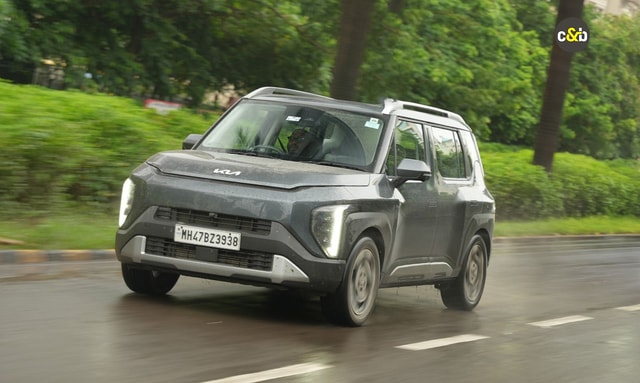TVS iQube S vs Bajaj Chetak: Comparison Review

Bajaj and TVS! Two storied brands, with rich history and heritage, stepped into the electric two-wheeler segment, almost at the same time! And today, it is time for them, once again, to go head to head. The Bajaj Chetak and the TVS iQube, both these scooters have been in the market for three years now and this is the first time we are pitting them against each other, because these two scooters are traditional rivals in the real sense.
TVS iQube vs Bajaj Chetak: Design
(The Chetak has a nice retro design, with a Vespa-like flavour. It gets excellent fit & finish)
The iQube and the Chetak are poles apart in terms of design and yet look quite handsome. The Bajaj carries a quintessential neo-retro design, with the round LED headlight, curved front apron and the Vespa-esque silhouette and a shapely rear section. The fit and finish on the Chetak is excellent all around, and the scooter looks quite proportionate. The single-sided swingarm at the rear and the trailing link suspension show off the lovely 12-inch alloys.
(The iQube gets a conventional design and is solidly built too)
The iQube on the other hand, is more conventional in its design. Solidly built, the design on the iQube has universal appeal, having a fine balance of form and function.
TVS iQube vs Bajaj Chetak: Features
(The iQube S now gets a 7-inch colour TFT display and it can be controlled by a 5-way joystick on the left switch cube)
There’s a 7-inch colour TFT display on the iQube which is nice and easy to read. The theme changes depending on the mode you ride in. Plus, the display also shows when the scooter goes into regen mode. The controls can be accessed via a 5-way joystick on the left switch cube, which feels intuitive to use. The centre-piece on the Chetak is the circular negative LCD display which shows a decent bit of info but is not the easiest to read, especially in bright daylight.
(The Chetak offers more practicality and a wider, comfier seat, but scores low on features)
Both scooters get Bluetooth and app connectivity, with call alerts, geo-fencing, USB charging port as standard along with full LED lighting and a low-speed reverse gear. The TVS iQube gets turn-by-turn navigation additionally. The Chetak and the iQube get 18 and 17 litres of underseat storage. The Chetak also has an additional cubbyhole on the inside of the front apron. In terms of features, the iQube S edges ahead, and in terms of practicality, the Chetak takes the win!
TVS iQube vs Bajaj Chetak: Performance
(The Chetak offers a nice, comfy ride and looks good on the move)
The Chetak makes more power but the iQube makes more torque. The Chetak has a rated top-speed of just 63 kmph, which may be a little too less for commuting duties, especially in bigger cities, but it makes up in other departments.
(The iQube S feels more planted and is the better handing scooter of the two)
If it is performance that you are looking for straight up then the TVS iQube is a better bet. It has higher top-speed of 78 kmph. It handles better thanks to the telescopic front for and it is lighter at 119 kgs. So if it is speed and performance that you are looking for, then the TVS iQube is a better bet. But if it is comfort that you are looking for and practicality, then the Chetak scores marginally higher in terms of ride quality and comfier ergonomics. Plus, thanks to its metal body, the Chetak weighs 133 kilograms, significantly heavier than the iQube.
(The TVS iQube is also the sprightlier of the two)
The iQube feels more planted at higher speeds and feels lighter on its feet. Both scooters offer decent braking performance, in terms of feel and bite. Both scooters have two riding modes – the Chetak has Eco and Sports while the iQube has Eco and Power.
(The Chetak charges quicker than the TVS)
As far as charging times are concerned, the Chetak takes less time to charge than the iQube. From zero, the Chetak takes about 4 hours to charge fully, while the TVS takes up to 4 hours 30 minutes to charge fully with a 650-watt charger.
TVS iQube vs Bajaj Chetak: Prices and Verdict
| Prices | Bajaj Chetak Premium | TVS iQube S |
|---|---|---|
| (ex-Showroom, Delhi) | Rs. 1,51,958 | Rs. 92,976 |
| (On-road, Delhi) | Rs. 1,57,943 | Rs. 1,09,256 |
Bajaj says that the Chetak is doing really well in rural and semi-urban areas, that’s because the brand, the name ‘Chetak’, still has a lot of pull. It is a beautifully crafted scooter, it looks really good, is well finished is proportionate and is comfortable and practical as well. But the footprint of the Chetak is not as widespread as the TVS iQube. So, the winner of this comparison has to be the TVS iQube because if you are looking for performance and features, the TVS iQube makes a lot of sense. Plus, the big deciding factor is the fact that this is priced at Rs. 1.10 lakh (on-road, Delhi) while that is priced at Rs. 1.58 lakh (on-road, Delhi). So, there’s a huge price difference and yes, the TVS iQube comes across as a more well-rounded package.
TVS iQube vs Bajaj Chetak: Specifications
| Specifications | Bajaj Chetak | TVS iQube S |
|---|---|---|
| Motor (Hub Mounted) | Permanent Magnet Synchronous Motor | Brushless DC Motor |
| Battery | Lithium Ion Battery (2.884 kWh) | Lithium-Ion Battery (3.04 kWh) |
| Max Power | 3.8 kW | 3 kW |
| Peak Torque | 20 Nm | 33 Nm |
| Gearbox | Single-speed Constant Mesh | Automatic |
| Front Suspension | Trailing Link | Telescopic |
| Rear Suspension | Monoshock | Adjustable Twin Shock Absorbers |
| Ground Clearance | 145 mm | 157 mm |
| Real World Range | 90 km (Eco Mode) 80 km (Sports Mode) | 100 km (Eco Mode) 75 km (Power Mode) |
| Weight | 133 kg | 118.8 kg |
| Top Speed | 63 kmph | 78 kmph |
| Underseat storage | 18 litres | 17 litres |
| Charging Time | 4 hours | 4 hours 30 mins (10-80%) |
Latest News
 car&bike Team | Jan 19, 2026Skoda Kushaq Facelift Debut Tomorrow: What To ExpectFacelifted Kushaq to get updated looks and new tech inside the cabin.1 min read
car&bike Team | Jan 19, 2026Skoda Kushaq Facelift Debut Tomorrow: What To ExpectFacelifted Kushaq to get updated looks and new tech inside the cabin.1 min read Jaiveer Mehra | Jan 17, 20262026 Tata Punch Facelift Price, Variants ExplainedUpdated Punch is available in 8 trim levels with naturally aspirated petrol, CNG and turbo-petrol engine options.3 mins read
Jaiveer Mehra | Jan 17, 20262026 Tata Punch Facelift Price, Variants ExplainedUpdated Punch is available in 8 trim levels with naturally aspirated petrol, CNG and turbo-petrol engine options.3 mins read car&bike Team | Jan 17, 2026Skoda Kushaq Facelift Teased Ahead of Launch In Coming WeeksMid-lifecycle update to bring with it styling updates as well as new features inside the cabin.1 min read
car&bike Team | Jan 17, 2026Skoda Kushaq Facelift Teased Ahead of Launch In Coming WeeksMid-lifecycle update to bring with it styling updates as well as new features inside the cabin.1 min read car&bike Team | Jan 16, 2026Pierer Mobility AG Rebranded as Bajaj Mobility AG Following KTM TakeoverThis marks a major shift in ownership and strategic direction in the global motorcycle industry.1 min read
car&bike Team | Jan 16, 2026Pierer Mobility AG Rebranded as Bajaj Mobility AG Following KTM TakeoverThis marks a major shift in ownership and strategic direction in the global motorcycle industry.1 min read Seshan Vijayraghvan | Jan 16, 2026Kia Syros Variant Line-Up Expanded With HTK (EX) Trim; Prices Start At Rs. 9.89 LakhPositioned between the HTK (O) and HTK+ trims, the new variant will be offered in both petrol and diesel options.2 mins read
Seshan Vijayraghvan | Jan 16, 2026Kia Syros Variant Line-Up Expanded With HTK (EX) Trim; Prices Start At Rs. 9.89 LakhPositioned between the HTK (O) and HTK+ trims, the new variant will be offered in both petrol and diesel options.2 mins read car&bike Team | Jan 16, 2026MG Majestor India Launch On February 12Unveiled in India at the 2025 Bharat Mobility Expo, the Majestor is expected to be positioned as a more premium alternative to the Gloster.1 min read
car&bike Team | Jan 16, 2026MG Majestor India Launch On February 12Unveiled in India at the 2025 Bharat Mobility Expo, the Majestor is expected to be positioned as a more premium alternative to the Gloster.1 min read
 Amaan Ahmed | Jan 17, 2026Bajaj Chetak C25 First Ride Review: Basic, Likeable E-Scooter For First-Time RidersThe Chetak C25, in quite a few ways, is poles apart from the larger and more powerful 30 and 35 Series models, but in its mannerisms, it is very much a Chetak.8 mins read
Amaan Ahmed | Jan 17, 2026Bajaj Chetak C25 First Ride Review: Basic, Likeable E-Scooter For First-Time RidersThe Chetak C25, in quite a few ways, is poles apart from the larger and more powerful 30 and 35 Series models, but in its mannerisms, it is very much a Chetak.8 mins read Bilal Firfiray | Jan 9, 2026Toyota Urban Cruiser Hyryder: 10,000 km Long-Term ReviewAfter spending over three months and 10,000 km with the Toyota Urban Cruiser Hyryder Hybrid, we were impressed by its real-world mileage, seamless hybrid, practical comfort, and Toyota reliability. Is it the best C-SUV then?5 mins read
Bilal Firfiray | Jan 9, 2026Toyota Urban Cruiser Hyryder: 10,000 km Long-Term ReviewAfter spending over three months and 10,000 km with the Toyota Urban Cruiser Hyryder Hybrid, we were impressed by its real-world mileage, seamless hybrid, practical comfort, and Toyota reliability. Is it the best C-SUV then?5 mins read Seshan Vijayraghvan | Jan 8, 20262026 Mahindra XUV 7XO Review: Big On Tech, Bigger On ComfortThe new Mahindra XUV 7XO is flashier, feature packed, and comes with more advanced tech. But are the changes just incremental or actually substantial?1 min read
Seshan Vijayraghvan | Jan 8, 20262026 Mahindra XUV 7XO Review: Big On Tech, Bigger On ComfortThe new Mahindra XUV 7XO is flashier, feature packed, and comes with more advanced tech. But are the changes just incremental or actually substantial?1 min read Preetam Bora | Jan 10, 2026Simple One Gen 2 First Ride Review: 265 km Claimed Range!The Gen 2 model of Simple Energy’s first electric scooter gets a fair few updates, including new features, tech, more range and lighter weight. We spent a couple of hours with the Simple One Gen 2 to find out if it manages to impress.6 mins read
Preetam Bora | Jan 10, 2026Simple One Gen 2 First Ride Review: 265 km Claimed Range!The Gen 2 model of Simple Energy’s first electric scooter gets a fair few updates, including new features, tech, more range and lighter weight. We spent a couple of hours with the Simple One Gen 2 to find out if it manages to impress.6 mins read Amaan Ahmed | Jan 3, 2026VLF Mobster 135 300 KM Review: Fun But FlawedA 125 cc scooter with Italian design and Chinese genes is a rare combination, and while some may be tempted to dismiss it because of its origins, the VLF Mobster shows 125s can also be exciting – but not without compromises.11 mins read
Amaan Ahmed | Jan 3, 2026VLF Mobster 135 300 KM Review: Fun But FlawedA 125 cc scooter with Italian design and Chinese genes is a rare combination, and while some may be tempted to dismiss it because of its origins, the VLF Mobster shows 125s can also be exciting – but not without compromises.11 mins read






















































































































